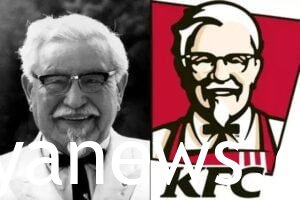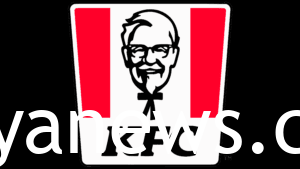KFC logo: In the world of fast-food giants, few brands are as iconic as KFC, short for Kentucky Fried Chicken. Founded by Colonel Harland Sanders in the 1930s, this fried chicken empire has a logo that’s instantly recognizable worldwide. However, have you ever wondered about the history behind the KFC logo and the meaning of each symbol? In this article, we’ll take a closer look at the evolution of KFC’s branding and what each element of their logo represents.
The Birth of a Legend: KFC logo
To understand the KFC logo’s history, we must first delve into the origins of the brand. Colonel Harland Sanders, the man behind the secret recipe of KFC’s delicious fried chicken, opened the first Kentucky Fried Chicken restaurant in Corbin, Kentucky, in 1930. As the franchise began to grow, the iconic logo emerged, signifying the brand’s expansion and evolution.

The First Logo
The earliest KFC logo featured a rather modest design. It primarily consisted of the words “Kentucky Fried Chicken” written in a simple, hand-drawn style, evoking a sense of authenticity and homemade goodness. This logo was used in the initial years of the brand, emphasizing the Southern charm and the Colonel’s dedication to providing “finger-lickin’ good” chicken.
The Introduction of the Colonel: KFC logo
In the early 1950s, the KFC logo underwent a significant transformation with the introduction of the iconic image of Colonel Harland Sanders himself. This addition was more than just a picture; it was a visual representation of the brand’s commitment to quality and taste. The Colonel’s distinguished look with his white suit, black bowtie, and goatee became synonymous with KFC’s promise of delicious, Southern-style fried chicken.
The Evolution of Typography
The KFC logo has seen various typography styles over the years, but the most notable change occurred in 1991 when a new script font was introduced. This new font added a touch of elegance and sophistication to the brand’s image, while still maintaining a sense of familiarity. It also made the Colonel’s face more prominent, reinforcing the idea that he was at the heart of the brand.
The Signature Red Color: KFC logo
One of the most striking elements of the KFC logo is the bold red color used throughout. Red is often associated with passion, energy, and, in the context of food, appetite stimulation. It’s no coincidence that KFC chose this color to entice customers with the aroma and flavor of their fried chicken. The red background also provides a stark contrast to the white suit worn by Colonel Sanders, making him the focal point of the logo.

The Meaning of Each Symbol
1.Colonel Harland Sanders:
The image of Colonel Sanders represents the founder of KFC and the man behind the secret recipe. His presence in the logo symbolizes tradition, quality, and the brand’s commitment to its roots.
2.The Script Font:
The script font used for “Kentucky Fried Chicken” adds an element of sophistication and timelessness. It suggests that KFC’s recipes have been passed down through generations and are prepared with care and attention to detail.
3.Red Background:
The bold red background is attention-grabbing and appetizing. It symbolizes the passion and energy that goes into making KFC’s fried chicken, as well as the brand’s fiery commitment to delivering a memorable dining experience.
The KFC logo has a rich history that reflects the brand’s evolution and commitment to delivering finger-lickin’ good chicken. Each element of the logo, from Colonel Sanders himself to the red background and script font, has a specific meaning that ties into KFC’s heritage and dedication to quality. Over the decades, this iconic logo has become a symbol of comfort food, a testament to the enduring appeal of Southern-style fried chicken. So, the next time you see the KFC logo, you’ll not only see a delicious meal but also a piece of American culinary history.


Comments are closed.